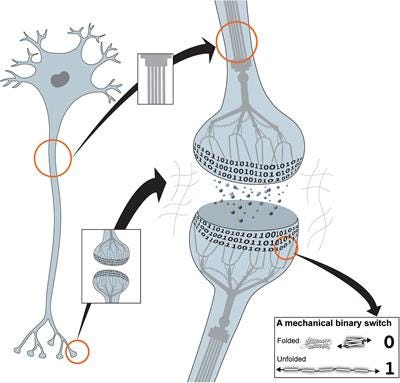MeshCODE Theory
Written by Christopher Dass
Introduction
Imagine if our memories were stored in a way similar to how computers save data. MeshCODE theory suggests exactly that—a groundbreaking idea proposing that the brain uses the physical arrangement of proteins, specifically talin molecules in synapses, to encode and store memories. This theory could reshape our understanding of cognition and memory.
What is MeshCODE Theory?
MeshCODE theory proposes that memories and information in the brain are stored through the physical setup of talin molecules within synapses. These talin molecules act like switches that can be turned on or off depending on the tension within the cell. The pattern of these switches (on or off) could represent information, much like binary code in computers.
How Does it Work?
Talin, a protein found in brain cells, has parts that can be activated (on) or deactivated (off) based on the tension within the cell. When the cell is at rest, all switches are off (0 state). However, when the cell is active, some switches turn on (1 state). This mechanical process allows for precise computations within each neuron, potentially creating a unique record of an organism's experiences and interactions.
Applications
Understanding the mechanical workings within neurons could lead to treatments for memory-related disorders such as Alzheimer's disease. It also suggests that biological systems can encode information similar to digital data, reflecting an organism's life experiences and interactions with the environment.
Research and Development
Ongoing research into MeshCODE theory aims to uncover how the configurations of talin molecules correlate with memory storage and cognitive processes. This theory challenges traditional views of memory formation and synaptic function, proposing a new approach in computational neuroscience.
Future Directions
As our understanding of MeshCODE theory grows, it may result in breakthroughs in enhancing cognitive abilities and developing targeted therapies for neurological diseases. By applying insights from computational neuroscience, MeshCODE theory holds promise for unlocking new aspects of brain function and memory retention.
Conclusion
MeshCODE theory represents a significant shift in neuroscience, suggesting that memories are encoded through mechanical configurations similar to binary code in computers. This innovative perspective could revolutionize how we understand memory storage and cognitive processes, potentially leading to new treatments and advancements in brain science.
Sources:
Barnett, S. F. H., & Goult, B. T. (2022, November 18). The meshcode to scale-visualising synaptic binary information. Frontiers in cellular neuroscience. https://www.ncbi.nlm.nih.gov/pmc/articles/PMC9716431/#:~:text=The%20theory%20proposes%20that%20the,junctions%2C%20organelles%20and%20the%20nucleus.
Goult, B. T. (2021, February 5). The mechanical basis of memory – the Meshcode theory. Frontiers. https://www.frontiersin.org/articles/10.3389/fnmol.2021.592951/full
Written by Christopher Dass from MEDILOQUY


